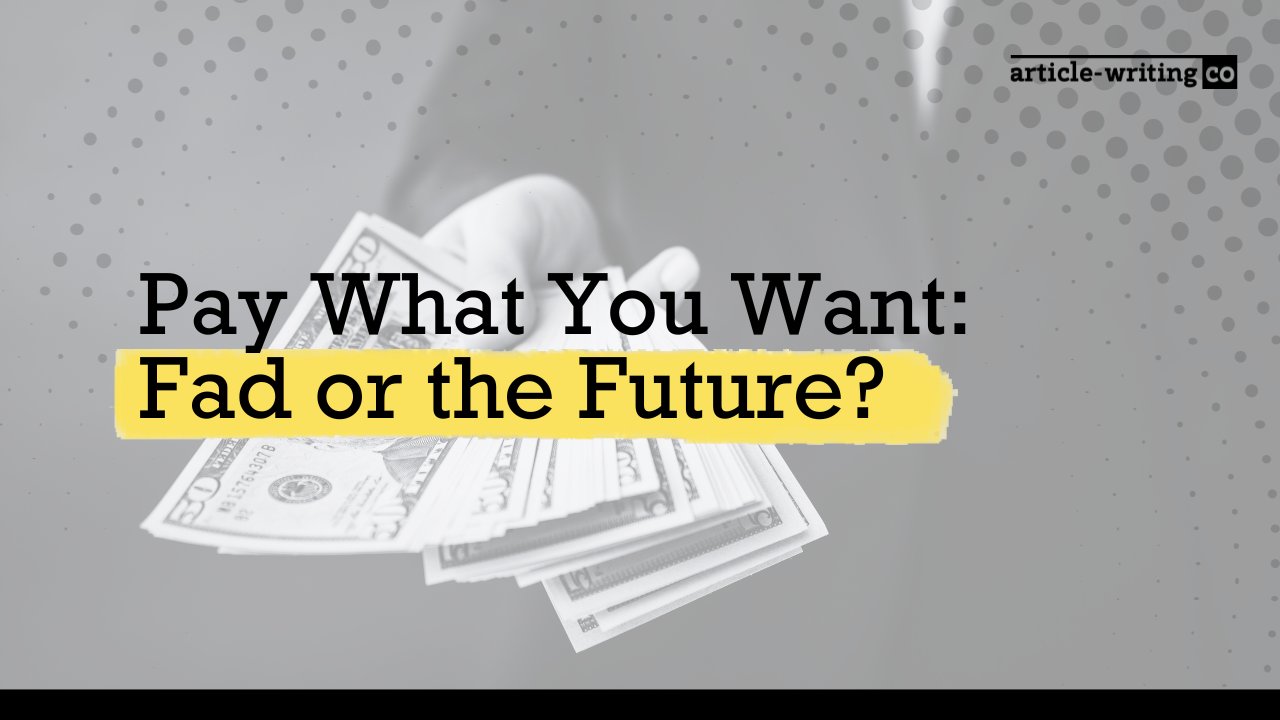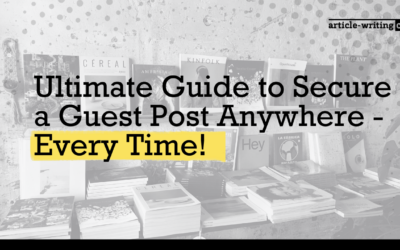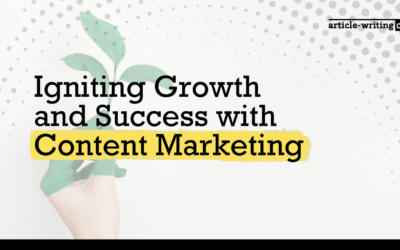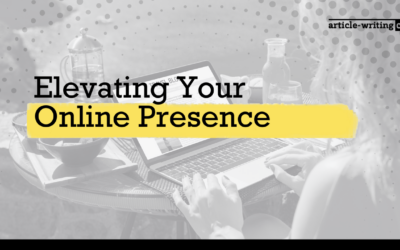Tom Morkes has received a lot of attention lately. The founder and CEO of Michigan-based Insurgent Publishing, Morkes has developed a new way of charging his clients for his work when they want to buy articles.
More specifically, he doesn’t charge them. Instead, he lets them decide how much his work is worth. Sound crazy? Don’t shoot down the idea just yet. Morkes explains how the system works to get people to buy articles in an exclusive Q&A with Article-Writing. You can connect with Morkes here.
AW: Explain how the “pay what you want” process works to get people to buy articles.
Morkes: Pay What You Want is a pricing technique that lets the customer choose his or her price. It’s essentially the opposite of the traditional fixed pricing model where the producer sets the price.
AW: This has received a lot of attention lately. Why do you think that is?
Morkes: Probably a culmination of a lot of reasons. First, the concept of the “gift economy” is becoming more and more popular and people are looking for ways to enter this new economy. Pay What You Want is a great way to do this. Beyond that, it’s been proven numerous times in small and large scale experiments that it can work (from books to music to restaurants to consulting), and awareness of this fact has continued to build momentum. Even million dollar seed funded tech startups are trying out PWYW pricing, like disconnect.me.
AW: I talked to a few business owners and managers about this concept, and all scoffed at the idea. Is this old-school thinking, or does this concept not apply to all businesses?
Morkes: I guess I would question if traditional fixed-pricing works in all instances. Obviously since we have alternative pricing techniques like bidding (eBay), there are times when fixed-pricing isn’t the best option. When it comes to PWYW pricing, no, it definitely doesn’t work in every situation or for all businesses. It doesn’t work for commodities (although if you see a PWYW gas station, let me know) or for corporations (what’s the incentive to contribute to McDonalds if they release a PWYW quarter-pounder-whatever?)
But consider for a moment the artisanal coffee shop down the street. You know the owner. He makes great coffee and he puts his heart and soul into it; you see it every time you order from him. Now if he makes his coffee PWYW, there’s an incentive to contribute – and GENEROUSLY, (1) because you love his work (2) because you know him personally.
And for the business owners and managers that scoff at PWYW: the record labels scoffed at Radiohead when they released In Rainbows online as PWYW and, well…you can Google how that one ended up.
AW: How do you convince those old-schoolers to give this idea a try and get them to buy articles using your model?
Morkes: I don’t. I’ll let them continue to use whatever pricing they like. But for those with whom it “clicks,” I like to show them examples and walk them through various ways it works (and ways it can completely fail). Nothing is a better teacher than experience (and case studies are the next best thing to personal experience).
AW: How long have you been doing this? Tell me the story behind how, and why, you came up with this concept.
Morkes: I’ve been using PWYW pricing for my writing since early 2013. I continue to sell all my books using PWYW pricing (and made over $5k doing this). I started a publishing company in late 2013 and use PWYW pricing in various ways for many of our products (including our premier business magazine, Bootstrapped). I’ve also started consulting in the last six months using PWYW, making anywhere from $15 to $250 per hour (with an average over $100 per hour). I recently co-launched an in-person business incubator program – the entire thing was PWYW. We ended up raising over $30,000 in commitments. After the in person incubator program launched, we launched a digital incubation program as PWYW and so far we’ve raised close to $10,000 for the first class.
I did it at first because I didn’t know how to price a book I wrote (it wasn’t a traditional book at all, more like a Cliff Notes of a conference with my thoughts and artwork in it). I decided to make it free but with a catch: people could contribute whatever they wanted to my creative work. I made $500 that first month from a free eBook and an email list of 166 people.
AW: How does this work for ongoing projects? I can see this working well for something like web design, which is often a one-and-done project where you send out one invoice. But what about weekly blog work?
Morkes: I don’t pitch PWYW as a blanket for everything I create. Some people do that, but I don’t. I’d rather very clearly give stuff away freely (blog posts), but then have other premium stuff where the customer can choose his price. Patreon.com actually provides a platform like this though that can be very powerful when used correctly. Evil Hat Productions does a great job with it (check them out here). So can it work? Yes, but there has to be very clear value of what is being created and why you’re using this pricing method.
AW: Have there been any times when this concept did not work for you? (as in, you received a much lower “donation” than the work was worth) How do you avoid those situations?
Morkes: I’ve written quite a number of guides and books. Some receive contributions and some don’t. I don’t think much would change if I changed the price to fixed-price – clearly, these were books and guides for the wrong crowd. On the other hand, some guides have made hundreds or even thousands. Just depends on the content and the audience (is it something they want?).
When I launched my book on PWYW pricing (yes, very meta), I made a huge mistake. I created bonus tiers for more generous contributors to my content (good idea). But to encourage preorders, I dropped the minimum they needed to contribute to get the bonuses (bad idea). The point of PWYW is generosity. Bonuses at certain contribution levels gives people a compelling reason to be generous. By lowering the contribution level for the bonuses, I was in effect saying: contribute the minimum. I expected to make about $3,000 from this book when I launched (a very rough guestimate), but ended up making $1,000. Since then, though, sales and contributions have increased considerably, so it wasn’t a complete loss.
AW: Are there any type of projects that you would not utilize this payment method?
Morkes: Possibly…just depends. I don’t plan to sell everything as PWYW forever. Some projects are better suited as fixed-price. There’s also a potential downside to using PWYW for everything you create – it may be perceived as lower value work. You can mitigate this with good sales copy and a solid launch (see the stats from the business incubator program above as an example), but for digital products like books/eCourses, it’s much harder to demonstrate true value consistently over time (primarily because new customers will always be hesitant or suspicious or simply won’t understand why I use PWYW pricing … I haven’t had time to develop a relationship with them yet).
AW: Generally speaking, do most people pay a reasonable amount to buy articles?
Morkes: Generally, as in: do 50 percent of people pay a reasonable price? No.
But the averages work out in most cases if you’ve set up your PWYW pricing the right way.
The majority of people take things for free or pay the minimum. Luckily, there are a small percentage of people out there who are incredibly generous, and their generous contributions dramatically shift the average.
AW: If they pay more than what you’d normally charge, why do you think that is?
Morkes: Because they understand my purpose, my story – my “why.” It’s something they buy into and they appreciate. They get why I’m doing this and they want to support me. And when they truly understand what I’m doing, it shifts the conversation from, “What’s the least I can pay for this transaction?,” to, “What’s the value of this product or service to me?” And that question changes everything.
AW: You’ve completed the job and spelled out to the client how this concept works. Now what? Do you send a gentle reminder that “donations are always welcome” after they decide to buy articles? Or do you just let it go?
Morkes: For clients, I use blank invoicing. They set the price to buy articles and pay after we’re done consulting. They know this going into the consulting. 95 percent of the time they contribute something. Other times, I’ve been offered skill exchanges (like video editing, artwork, etc.).
AW: Instead of giving customers the option to “pay what you want,” when you want them to buy articles what about offering a portion of your products or services for free? As an example, a content marketing firm could offer a free article as a way to show potential clients what they’re capable of. Assuming the work is solid, you’d think the potential client would now want to hire that firm for ongoing work. Good idea or bad idea? Please explain. .
Morkes: Yes, good idea – but not PWYW nor gift economy. This is essentially the freemium model: you give a teaser of what’s possible which leads to an upsell. It’s a brilliant business model for the right businesses because you can build trust up front with a free offer, and there’s deep psychology at work here (read: Cialdini’s Influence for more on this topic). If you wanted to adopt PWYW, I would recommend testing it out with current clients. Just send them a blank invoice and see what happens. If they contribute generously, continue using the model. If they take advantage of the offer to lowball you, you don’t have to use the invoicing again.
Or go one step further and make all your content marketing PWYW pricing (you’ll need to educate your clients on WHY and HOW it works, but could be amazingly powerful – I don’t know of any content marketers doing this right now, so you’d stand out from the pack in a big way).

David is the Founder and Director of article-writing.co, the fastest-growing content creation agency in North America. He has transformed companies by offering high-quality content that has impacted their SEO ranking, revitalized websites with engaging and industry-relevant blogs and website copy, and championed successful email campaign copy.





